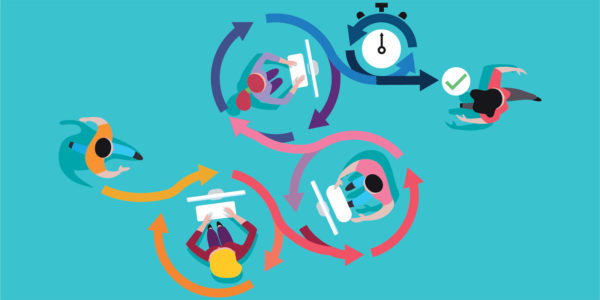How to Build an Agile Sales Force

Webster’s definition of “agile” is “having a quick, resourceful, and adaptable character.” To be agile is to have the ability to adapt individual behavior based on the situation the person is facing. Individuals who are agile read the situation, use the information they uncover to choose the best course of action, execute that action, monitor changes in the situation, and adjust their actions as needed.
Agility is cyclical and involves making good decisions, acting on those decisions, determining the impact of those actions, and beginning the decision-making process again. The quality of the decisions impact both the quality and efficacy of the individual actions taken.
Do Salespeople Need To Be Agile in The Sales Approach They Use?
Research by the Florida State University Sales Institute (and further validated by VantagePoint) identified that top-performing sellers choose their sales approach based on the buying situation they are facing. Average and low performers use the same sales approach regardless of the buying situation – for example, a consultative selling approach or disruptive approach (Challenger) in all selling situations. High-performing salespeople understand that agility is the secret to success.
And Then, How Do You Train Sales Agility?
Selling with agility involves
- Assessing the situation: Drawing a picture of the buyer using a deep understanding of the buying factors that matter most.
- Choosing the best sales approach: Aligning the buying situation with the sales objectives and the most impactful sales tactics.
- Executing those tactics: Acting with effectiveness and efficiency while assessing buyer reaction and determining if a new choice needs to be made.
VantagePoint’s Approach to Sales Agility
Assessment is the foundation of sales agility, and salespeople often short-change or overlook it. Let’s face it: Most sales training focuses exclusively on execution. Agile sellers pause and take the time to assess the buying situation by seeking information and making sense of the buying factors.
Which factors? Our research has revealed five categories of factors that consistently impact customer buying situations:

As you may suspect, there are multiple buying factors in each category; however, these five categories focus sellers on what to look for in order to get an accurate picture of the buying situation they are facing. Through our research with multiple organizations across various industries, we have identified four common buying situation archetypes, as well as the patterns of sales behavior most effective for each situation archetype.
Once the buying situation is assessed, sellers then need to choose the sales approach that is most likely to lead to a win based on the buying situation they are facing. Our research has validated that there are four primary patterns of sales behavior exhibited by high-performing sellers:

Each of these patterns is effective under certain buying conditions and aligns with a particular situational archetype. We teach sellers to read the buying situation, choose the pattern of selling behavior most appropriate for the buying situation they are facing, and then to execute that sales approach effectively while monitoring buyer reactions.
AgileEdge® Uses Machine Learning to Be More Precise
For many organizations, the above approach is game changing. Yet there are other organizations that want more precision. They want to know the precise buying factors that most strongly influence the buying situations their sellers face. They also want to replicate the behavior of their top performers and know how they win in the various buying situations.
For these customers, VantagePoint does two things.
First, we use deal-level data and machine learning to identify and distinguish the characteristics of the most common buying situations encountered. The interplay of those factors can then be analyzed – allowing us to clarify the unique buying situations faced by sellers for the organization or business unit. For example, across a large organization with multiple business units, the buying factors may remain constant, but the buying situation clusters may differ.
Second, we use machine learning to uncover the sales tactics used in each buying situation and how they cluster to form patterns of sales behavior that lead to wins for each situation.
Real Example: In the client example below, the line chart shows the five factors that were most predictive of changes in seller behavior and how those factors clustered to form a unique buying situation for that client. The bar chart shows the most optimal and least optimal selling strategy for two distinct business units.
Interestingly, for business unit 1, the least optimal strategy was the most optimal strategy for business unit 2. Imagine if we gave this client the advice that they should use only a consultative approach in a “Tell Me” situation. This would work well for business unit 2, but completely backfire for business unit 1.

This level of precision enables our customers to clearly understand the buying situations their sellers face, as well as the sales approach most likely to lead to a win in each buying situation.
Whichever approach our customer takes to gathering situational intelligence, we then train their sellers how to assess buying factors present in their deals, recognize the relevant buying situation, choose the strategy most likely to win, and then execute that sales strategy effectively. This is a very precise method of sales enablement and can work for tenured sellers as well as new hires.
You’re likely hiring new salespeople on an ongoing basis. Imagine equipping them to understand how your buyers buy and how your top performers win most of their deals? You’ll see a remarkable impact to their success acceleration!
So how does this model for agility work for sales managers? Do the same principles apply?
Yes, indeed they do. Let’s explore this a bit further…
- Situational Intelligence: Managers must determine the metrics most aligned to the results they are targeting, and which activities must be coached to align to those metrics.
- Situational Readiness: Managers build out coaching plans (standard operating procedures) for how and when to coach to those activities in a rhythm of coaching conversations.
- Situational Fluency: Managers are trained and drilled on how to identify the highest-impact activities, build the right rhythms, and conduct coaching conversations that have impact on the prioritized KPIs.
This is different from how most managers are trained to coach their sellers. Most coaching programs focus on “how to coach.” This is a very serious flaw in sales manager enablement. Managers who are trained only on “how to coach” rarely show adoption of the coaching model they’ve learned because they haven’t done the heavy lifting of operationalizing the coaching approach into their everyday sales management world.
If you want to enable sales managers in a way that drives real performance, managers must be trained in a way that reflects their real world. VantagePoint is the only company that does that. And we do it by teaching sales managers how to
- Align the activities to results: Managers must first determine the situation they are facing by identifying the outcomes they are looking to drive within their sales team. The desired outcomes determine the activities that must be coached. The coaching plans (standard operating procedures) ensure coaching is aligned to the desired outcomes.
- Execute coaching plans: Managers execute their coaching according to their individual coaching plans – strictly adhering to the coaching rhythms identified.
- Assess impact: Managers monitor changes in leading indicators (KPIs) to assess whether the appropriate progress is being made. Changes to the activities they coach and how and when to coach is an ongoing process that enables them to coach in an agile, adaptable way over time.
But what about replicating the behavior of top-performing managers? Can we gain precise insight about manager behavior the way we can with seller behavior?
Well, fortunately, the answer is yes. We can first identify the sales objectives (or KPIs) that high-performing managers focus on and to what degree. We can then determine the pattern of activities that top-performing managers focus on to drive performance. In essence, we can isolate which objectives and activities top performers attend to obtain better outcomes.
Real Example: In the client example below, you can see the strategic objective focus of high-performing managers versus core-performing managers on the left.
Note that the high-performing managers have a significantly higher focus on selling new products and services compared with core performers. On the right, you can see which five activities – of all the activities we measure – are most highly related to sales performance. You will notice that one of the five highest-impact activities is studying the specifications of new products and services. This linkage should not only be apparent, but it should also align with organizational objectives and KPIs.

Finally, we can isolate the specific coaching practices that top performers utilize to drive better outcomes. Using VantagePoint Performance, you can identify the activities they coach, the frequency and duration of their coaching conversations, and the topics they cover to drive results.
If you are like our clients who want a precise understanding of high-performing management practices, you now have a method for obtaining that critical information. With VantagePoint you have choice and flexibility, which means your seller and manager training investments are aligned internally to organizational goals, as well as aligned externally to your customer’s buying behaviors and preferences.
Michelle Vazzana, Ph.D., is chief strategy officer and co-founder of VantagePoint Performance.
Get our Enewsletter
Get the latest sales leadership insight, strategies, and best practices delivered weekly to your inbox.
Sign up NOW →